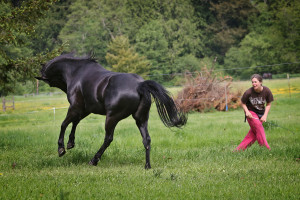In the wild horse herd, survival depends on being moved by a lead horse and this is tightly wired in the equine neurology. Wherever I go, I see people being moved by their horses instead of the other way around. When a horse sees you as someone they can run over they loose complete respect for you. To be seen as a confident leader, you must be able to move the horse.
This is often done suddenly from behind when the horse has ignored the person. From a herd preservation standpoint, the horse that ignores cues from the leader may get hurt or killed by predators. Therefore, horses are embarrassed that they took their attention off you and when you move them, they can seem momentarily upset. But even an aggressive horse will thank you so much later for finally “showing up” in his world.
Fill a food pan with pieces of apples or good molasses grain, the kind saved only for training (see management section.) Use this as his special food and move him from behind when he has ignored you so you can claim his grain. The level of aid (crack of a whip or sound of a reed in the wind) varies horse to horse depending on his level of fear and comfort with people. After you claim his spot by the food, you must remain for long enough to make sure he lowers his head and accepts or turns away to ignore. You can play with the food as he watches to make it clear that he can only eat when you allow him to (for this work period) and that you own the food, not him.
The horse must always be able to get away with a large enough field or paddock and always have access to hay or other lesser quality food. You can work with him alone or with other horses. Do not change the direction of your feet to accommodate for him. He needs to respect you enough not to enter your space.
Your level of energy depends on the individual personality of the horse (is he fearful or bold) and what you are trying to accomplish. You might need to shrink your energy, rounding your shoulders into a submissive stance to ask a fearful horse to come circle close around you. Or you may have to magnify your energy standing up tall, radiating power through your solar plexus if your aggressive horse is not listening. Likewise, your whip position is very important. A shy horse like Tino just needs a reed low to the ground and back behind me, while a fearless horse like Mick might need a bigger whip directed at his shoulder or even a flag. With a very aggressive horse, you might need two flags to move the horse.
Look for signs of acceptance: the horse’s head is down, his muscles relaxed, his movements slow, chewing. Allow time for him to “absorb the chew” (see credits) and your training. Know where you want him to move but once you arrive there, give him time to reflect on what just happened. During this reflection time, do not demand anything from him. Find peace within yourself. Let go of your goals and lists. Just be present in his or her beauty.
When you allow him to return to his food, it’s good to slowly walk about 20 feet behind him watching to see if he turns his body to keep an eye on you and then with minimal aids again be allowed to take the space. Allow time for processing. Then go to the front and gradually approach to say hello again. It’s also good to allow time for just being with your horse. If he is sticky about moving after several times asking, then slowly keep him moving around the paddock. This slow methodical movement (careful not to corner him) is important for fearful horses as it reassures him that you are looking out for his well being. Try halting your energy and see if he halts too.

